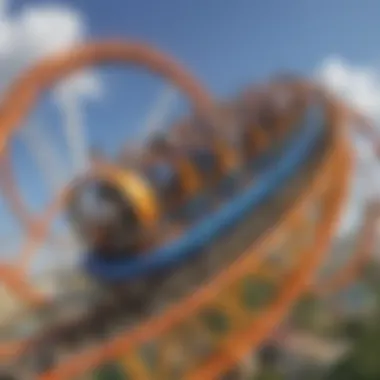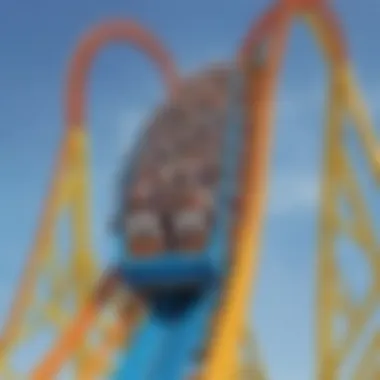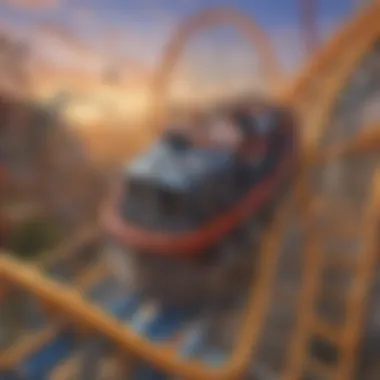The Gravity-Defying Thrills of Riding an Exhilarating Roller Coaster


Science Fun Facts
Did you know that roller coasters can trace their origins back to the 17th century when Russian ice slides were modified to include wheeled carts? This fascinating twist had an unexpected ripple effect, paving the way for modern-day thrill rides that defy gravity and delight millions of visitors each year. The first known roller coaster in America, the Mauch Chunk Switchback Railway, opened in the 1820s to provide coal miners with a gravity-powered transportation thrill after a day's work. This historical nugget sets the stage for understanding the evolution of roller coasters and their enduring appeal.
While roller coasters are synonymous with adrenaline rushes and heart-pounding excitement, they are also a feat of engineering prowess and physics mastery. The design of roller coasters relies on concepts such as potential and kinetic energy, inertia, and centripetal force to create those stomach-churning drops, loops, and twists that leave riders exhilarated. Understanding the science behind these dynamic structures adds a layer of appreciation for the artistry and intricacy that goes into crafting a roller coaster experience.
Discover the Wonders of Science
Delving deeper into the mechanics of roller coasters reveals a captivating world where art and science intertwine. Videos and animations showcasing the engineering marvels behind these rides offer a behind-the-scenes look at the precision and calculation involved in every loop and turn. Exploring the real-life applications of physics concepts in action-packed settings sparks curiosity and illuminates the practical side of science that shapes our everyday experiences. Through interactive tools and educational resources, the magic of roller coasters becomes a gateway to understanding gravity, velocity, and the thrilling possibilities of pushing the boundaries of physics.
Science Quiz Time
Enter the realm of brain-teasing challenges and interactive quizzes designed to test your knowledge of roller coaster science. From multiple-choice questions probing the depths of physics principles at play to puzzles that unravel the mysteries of G-forces and momentum, this quiz time promises a journey of discovery and learning through gamification. Unravel the enigmas of centrifugal force, acceleration, and ride dynamics as you traverse through the twists and loops of these scientific conundrums. Each quiz question is a gateway to unraveling the secrets of roller coaster thrills and the science that propels them.
Science Experiment Showcase
Venture into a realm of hands-on exploration with fun and engaging experiments that bring the physics of roller coasters to life. Follow step-by-step instructions to create your mini roller coaster using household materials, understanding the science of momentum and gravity in action. With a detailed materials list and safety tips at your disposal, embark on a thrilling journey of experimentation where scientific principles become tangible through DIY ingenuity. Experience the thrill of discovery as you engineer your miniature coaster and witness firsthand the laws of physics in action, all within the safety of controlled experimentation.
Introduction
Riding a roller coaster is an exhilarating experience that combines thrills with engineering marvels, providing riders with an adrenaline rush like no other. The Introduction to the world of roller coasters sets the stage for a journey through the physics, design, history, and impacts of these gravity-defying rides. It serves as a gateway to understanding the sheer excitement and complexity that goes into creating and experiencing a roller coaster ride. This section will delve into the essence of roller coasters, offering insights into their appeal and the elements that make them a staple in amusement parks worldwide.
Definition of a Roller Coaster
A roller coaster, often referred to as a thrill ride, is a type of amusement park attraction that consists of elevated railroad tracks on which vehicles travel. These vehicles, typically consisting of carts or trains, navigate sharp turns, steep drops, and inversions at high speeds, providing riders with a dynamic and thrilling experience. The defining feature of a roller coaster is its ability to harness gravitational forces to propel riders through a series of twists and turns, eliciting screams of excitement and joy.
Brief History of Roller Coasters
The history of roller coasters dates back to the 17th century when the precursor to modern-day coasters emerged in Russia. These early Russian ice slides paved the way for the development of more sophisticated wooden roller coasters in the 18th and 19th centuries. The first known roller coaster in America, the Mauch Chunk Switchback Railway, introduced the concept of mechanical propulsion, revolutionizing the amusement park industry. Over the years, roller coasters have evolved from simple scenic railways to high-tech thrill machines, captivating audiences with their daring designs and pulse-pounding experiences.
Purpose of Roller Coasters


The primary purpose of roller coasters is to provide entertainment and excitement to riders of all ages. These adrenaline-pumping attractions offer a sense of escapism and adventure, allowing individuals to experience the thrill of speed and height in a controlled environment. Roller coasters also serve as feats of engineering prowess, showcasing innovative design concepts and pushing the boundaries of what is physically possible. Whether it's the sense of weightlessness during a drop or the exhilaration of a loop-the-loop, roller coasters are designed to stimulate the senses and leave a lasting impact on those who brave their twists and turns.
Physics Behind Roller Coasters
In this comprehensive exploration of the fascinating world of roller coasters, an in-depth understanding of the physics governing these thrilling rides is paramount. Physics Behind Roller Coasters delves into the core principles that dictate how roller coasters move, loop, and exhilarate riders.
Centripetal Force and Inertia
Centripetal Force and Inertia play a fundamental role in the spectacular maneuvers of roller coasters, defining how riders are propelled around sharp corners and through inversions. The Centripetal Force keeps passengers securely in their seats as the coaster navigates bends, while Inertia ensures a smooth transition from one element to the next.
Gravity's Role in Roller Coaster Dynamics
A key player in the gravity-defying experience of roller coasters, gravity influences the speed, momentum, and overall dynamics of the ride. By working alongside other forces, gravity contributes to the intense drops, twists, and climbs that define a roller coaster's exhilarating journey.
Acceleration and Deceleration in Roller Coasters
Acceleration and deceleration are essential components of the roller coaster experience, dictating how quickly riders speed up, slow down, and transition between different sections of the ride. Understanding the intricacies of acceleration and deceleration provides insights into the hair-raising thrill and seamless flow of a roller coaster's ride profile.
Engineering Marvels of Roller Coasters
Roller coasters stand at the intersection of engineering prowess and thrilling entertainment. In this section, we delve into the vital aspects that define the engineering marvels of roller coasters, showcasing the intricate blend of science and design that culminates in these awe-inspiring structures.
From the meticulous track design to the selection of cutting-edge materials, every element plays a pivotal role in ensuring a safe yet exhilarating ride for thrill-seekers. The complexities involved in balancing speed, height, and G-forces require a meticulous approach to engineering.
Track Design involves a symphony of curves, drops, loops, and inversions that must be precisely calculated to deliver a seamless ride experience. Engineers utilize advanced software and simulation tools to test the dynamics of the coaster, ensuring that riders are treated to the perfect combination of excitement and safety.
Materials selection is equally crucial, with engineers opting for high-strength alloys and composite materials to withstand the forces exerted during the ride. The durability and flexibility of these materials are key factors in ensuring the longevity and reliability of the roller coaster structure.
Safety Systems form the backbone of roller coaster design, incorporating redundant systems and fail-safes to protect riders at all times. From sensor-based monitoring to automatic braking systems, every precaution is taken to mitigate potential risks and enhance passenger safety.
Innovations in Roller Coaster Technology continue to drive the evolution of these adrenaline-pumping attractions. From magnetic propulsion systems to virtual reality integration, engineers are constantly pushing the boundaries of what is possible, delivering new and thrilling experiences to amusement park visitors.
The engineering marvels of roller coasters not only exhilarate but also inspire, showcasing the best of human ingenuity and creativity in the pursuit of ultimate amusement park thrills.


Psychological and Physiological Effects on Riders
The exploration of Psychological and Physiological Effects on Riders within the realm of roller coasters unveils a captivating dimension of human experience triggered by these gravity-defying rides. Understanding the impact of roller coasters on the mind and body is crucial to grasp the full extent of their allure. This section delves into the intricate interplay between the psychological responses and physiological sensations induced by the exhilarating roller coaster experience. By dissecting the psychological and physiological effects, we can appreciate the complexity of emotions and physical reactions that riders undergo during and after the thrill ride.
Adrenaline Response While Riding
The adrenaline response while riding a roller coaster is a paramount aspect of the entire experience. As riders plummet down steep drops, twist through sharp turns, and soar through inversions at breakneck speeds, their bodies undergo a surge of adrenaline - the 'fight or flight' hormone. This physiological reaction triggers heightened senses, increased heart rate, and a rush of energy, intensifying the feelings of excitement and thrill. The release of adrenaline not only adds to the exhilaration of the ride but also leaves a lasting impact on the riders' overall mood and state of alertness post-ride.
Fear and Enjoyment Factors
Delving into the fear and enjoyment factors embroidered within the tapestry of roller coaster riding unearths a blend of opposing yet complementary emotions. While fear may initially instill a sense of apprehension and anxiety in riders, it eventually gives way to an electrifying sense of enjoyment and euphoria as the ride progresses. The intricate balance between fear and enjoyment creates a unique cocktail of emotions, heightening the overall roller coaster experience and leaving riders with lasting memories of conquering their fears while relishing the pure joy of the ride.
Physical Sensations Experienced
The physical sensations experienced during a roller coaster ride are a symphony of thrill and physical feedback that propel riders into a realm of sensory overload. From the intense G-forces pressing against their bodies during loops and corkscrews to the exhilarating wind rushing past their faces as they accelerate down steep descents, every moment on a roller coaster is a visceral journey through a kaleidoscope of sensations. These physical stimuli not only provide an electrifying experience but also challenge riders' physical endurance and ability to withstand the forces exerted upon them, adding a layer of physical challenge to the psychological and emotional roller coaster of the overall ride.
Famous Roller Coasters Around the World
Famous roller coasters hold a significant position in the realm of amusement parks and thrill-seekers worldwide. These iconic structures symbolize innovation and engineering prowess while providing exhilarating experiences. When discussing renowned roller coasters, one cannot ignore their historical importance and cultural impact. They are not merely attractions but landmarks that generate awe and admiration.
Top Steel Roller Coasters
Among the various types of roller coasters, steel coasters stand out for their smoothness, speed, and dynamic maneuvers. Top steel roller coasters are revered for their advanced technology and record-breaking features. These coasters often push the boundaries of design, offering riders intense loops, inversions, and breathtaking heights. The experience of riding a top steel roller coaster is unmatched, delivering adrenaline-fueled thrills and unforgettable memories.
Notable Wooden Roller Coasters
Wooden roller coasters, despite their traditional roots, continue to captivate riders with their classic charm and nostalgic appeal. Notable wooden coasters combine artisan craftsmanship with thrilling elements, creating a unique blend of old-school excitement and modern engineering. These coasters showcase the enduring popularity of wooden construction in the midst of steel dominance, providing a timeless experience cherished by enthusiasts of all ages.
Unique Themed Roller Coasters
Themed roller coasters offer an immersive journey beyond mere thrills, transporting riders into fantastical realms and story-driven adventures. Unique themed coasters are designed with intricate details, elaborate decorations, and thematic elements that elevate the ride experience to new heights. Each element of these coasters contributes to the storyline, ensuring that riders not only feel the adrenaline rush but also become part of a larger narrative woven into the ride's design. Riding a themed coaster is akin to stepping into a different reality, where every twist and turn is part of a grand, cinematic escapade.
Safety Measures and Regulations


The landscape of amusement parks is tightly knit with regulations and safety protocols aimed at ensuring the well-being of riders. In the context of roller coasters, Safety Measures and Regulations play a critical role in mitigating risks and providing a secure experience for park visitors. These regulations encompass a wide array of areas, including ride inspections, maintenance standards, emergency response preparedness, and rider restrictions. By adhering to these stringent guidelines, theme parks can uphold their commitment to delivering a thrilling yet safe experience for all patrons.
Inspections and Maintenance Protocols
Inspections and Maintenance Protocols form the cornerstone of roller coaster safety. These rigorous procedures involve routine checks of the ride's structural integrity, mechanical components, and safety features. Trained inspectors meticulously examine every inch of the coaster, ensuring that it meets strict industry standards. Regular maintenance schedules are implemented to address wear and tear, preventing potential malfunctions that could jeopardize rider safety. By diligently adhering to these protocols, amusement parks foster a culture of safety and accountability, instilling confidence in visitors regarding the reliability of the rides.
Rider Height and Health Restrictions
Rider Height and Health Restrictions are vital components of roller coaster safety measures. These restrictions are in place to safeguard individuals who may be at higher risk due to health conditions or physical limitations. Height requirements ensure that riders are properly secured in their seats and can safely withstand the forces of the coaster's movements. Health restrictions, such as heart conditions or pregnancy, aim to prevent any adverse effects that the intense ride dynamics may have on vulnerable individuals. While these restrictions may disappoint some eager riders, they ultimately prioritize the well-being of all guests, promoting a culture of inclusivity and care within the theme park environment.
Emergency Response Procedures
In the event of unforeseen circumstances, Emergency Response Procedures are meticulously laid out to handle any potential emergencies swiftly and effectively. Park staff receive extensive training on evacuation protocols, first aid response, and communication strategies to ensure a coordinated and rapid response to any incidents. From minor delays to more serious situations, such as ride stoppages, these procedures are designed to prioritize guest safety above all else. By rehearsing these protocols regularly, theme parks exhibit a commitment to readiness and preparedness, reassuring visitors that their well-being is the park's top priority.
Environmental Impact of Roller Coasters
Roller coasters are not only thrilling and exciting but also come with a significant environmental impact. Understanding and addressing the environmental considerations of roller coaster operations are crucial in today's world. This section will delve into the key aspects of the environmental impact of roller coasters in detail, shedding light on their energy consumption, sustainability efforts, noise and visual pollution mitigation strategies, and land-use considerations for their development.
Energy Consumption and Sustainability Efforts
One of the primary concerns regarding roller coasters is their energy consumption. The operation of roller coasters requires substantial amounts of energy, predominantly for propelling the carts up steep inclines and through various twists and loops. It is essential for amusement parks to implement sustainable practices to minimize the environmental footprint of roller coasters. Key efforts include utilizing energy-efficient technologies, incorporating renewable energy sources like solar and wind power, and optimizing ride operations to reduce energy wastage.
Noise and Visual Pollution Mitigation
Roller coasters are known for their exuberant screams and roaring sounds as they zip around their tracks. However, excessive noise from these rides can disrupt the tranquility of surrounding areas. Amusement parks often employ noise mitigation strategies such as sound barriers, landscaping, and scheduling ride operations to reduce noise levels. Additionally, minimizing visual pollution caused by large structures like roller coasters is vital. Parks integrate aesthetic elements, such as themed designs and natural landscaping, to blend roller coasters harmoniously into the surrounding environment.
Land-Use Considerations for Roller Coaster Developments
When constructing new roller coasters or expanding existing ones, careful consideration must be given to land-use planning. Roller coaster developments can occupy significant land areas, potentially affecting ecosystems and natural habitats. Parks need to conduct thorough environmental impact assessments before embarking on construction projects to mitigate adverse effects. Incorporating green spaces, preserving natural features, and exploring sustainable construction practices are essential for responsible roller coaster development that respects the environment and local ecosystems.
Conclusion
Roller coasters hold a profound significance in the world of amusement parks, not merely as a source of thrills but as a testament to human creativity and engineering ingenuity. The Conclusion section of this article serves as a critical reflection on the impacts of roller coasters on society and culture. It encapsulates the essence of these gravity-defying constructs, highlighting their multifaceted influence on our lives. By delving into the broader ramifications of roller coasters, we can appreciate the interplay between entertainment, technology, and societal norms.
When contemplating the Conclusion of this discourse, it becomes evident that roller coasters are more than mere rides; they are cultural icons that transcend mere amusement. The blend of adrenaline-pumping experiences, architectural design, and historical evolution contributes to a narrative that echoes throughout generations. By examining the impacts of roller coasters on society and culture, we can unravel a tapestry of emotions, memories, and shared experiences that bind individuals from diverse backgrounds and age groups.
Exploring the social and cultural impacts of roller coasters unveils a treasure trove of insights into human behavior, preferences, and societal values. From fostering a sense of community among park visitors to influencing artistic expressions in popular culture, roller coasters play a pivotal role in shaping our collective identity. This section aims to demystify the allure of roller coasters by peeling back the layers of excitement and dissecting the deeper implications of these towering structures.
In essence, the Conclusion segment serves as a gateway to introspection, prompting us to ponder the profound effects of roller coasters on our perceptions of leisure, innovation, and collective experiences. As we journey through this exploration of roller coasters, we are invited to not only marvel at the engineering feats behind these colossal rides but also to ponder the profound ways in which roller coasters have left an indelible mark on society and culture.







